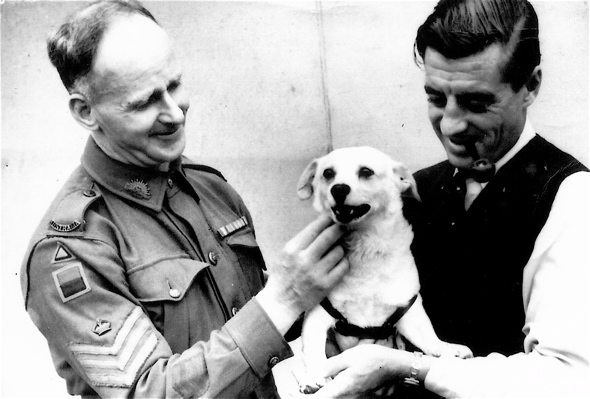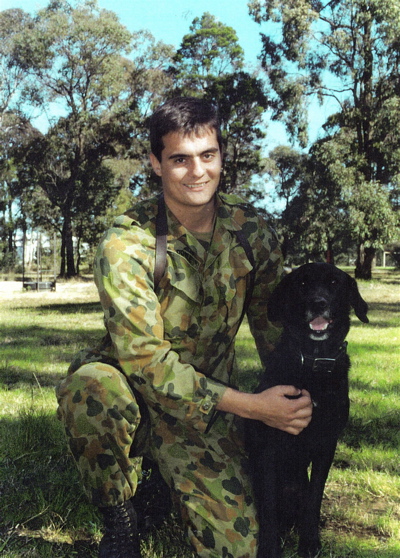For more info
For more information go to the background article Writing Animal Heroes in which Anthony tells what inspired him to write the book and the respect he hopes everyone will feel for the animals who have served our nation's forces. Look at the many wonderful photographs of Animal Heroes at the Australian War Memorial > collections > animals. This page also has a complete set of Chapter Notes to Animal Heroes with the References and Further Reading guide. Official records on Horrie can be seen online at the National Archives of Australia> Recordsearch > Guest > Horrie 1945
Animal Heroes Q&A
Why did you write Animal Heroes?
 At the launch of my book Young Digger, a friend told me the secret story of Horrie the Wog Dog, another war mascot smuggled home, this time by Private Jim Moody, pictured (right) with Horrie and Sergeant Roy Brooker. At the launch of my book Young Digger, a friend told me the secret story of Horrie the Wog Dog, another war mascot smuggled home, this time by Private Jim Moody, pictured (right) with Horrie and Sergeant Roy Brooker.
Ion Idriess published Horrie's story in 1945, amid real public anger when it was thought the quarantine authorities had destroyed Horrie. This new ending was such a "twist to the tail" I knew it had to be written.
I confirmed the story with Jim's family and mates, and decided to include it with a series of stories about animals who have served with Australian military forces.
How are animals used in war?
 From time immemorial people have taken animals to war. Cavalry horses were used to charge the enemy. Pigeons carried messages from the front back to headquarters. Mules and donkeys transported weapons and supplies. From time immemorial people have taken animals to war. Cavalry horses were used to charge the enemy. Pigeons carried messages from the front back to headquarters. Mules and donkeys transported weapons and supplies.
Dogs have always had a special place in human affairs. They have been trained to track enemies, to sniff for weapons and explosives, and used as patrol or messenger dogs.
During the First World War, dogs were even taught to be ambulance assistants, carrying medical supplies and bandages to the wounded, as this French postcard shows from 1914.
Are animals still used in war?
 Yes indeed. Although armies are highly mechanised, explosive detection dogs, tracker dogs and guard dogs still have an important place in military life. They have special abilities with scent and hearing that cannot be replaced. Yes indeed. Although armies are highly mechanised, explosive detection dogs, tracker dogs and guard dogs still have an important place in military life. They have special abilities with scent and hearing that cannot be replaced.
In Afghanistan Australian SAS forces used donkeys to carry supplies into the mountains. And in Iraq, Australian navy divers worked alongside bottle-nosed dolphins trained by the US military to check for possible underwater mines.
Until recently, quarantine fears meant that most of the animals taken overseas by Australian forces never came back.
Of the 135,000 horses who left Australia during the First World War, the only one who came home was Sandy, the favourite charger of the first AIF commander, General Bridges. None of the 11 black Labrador tracker dogs taken to Vietnam returned – something which still grieves the men and women who knew them.
The good news is that today the war dogs taken overseas do come back – like Boris who served in East Timor, pictured here with his handler Lee Doyle. When Boris retired he became Lee's family pet. And Vale Boris! After a wonderful 16 years, he died in early 2009.
And there's more good news. Australian military dogs now qualify for the world's first canine service medals. Those who serve overseas receive the War Dog Operational Medal with Clasps, and those who serve for five years at home get the Canine Service Medal.
Recognised at last! True Animal Heroes!
|